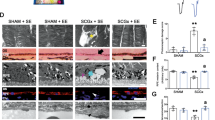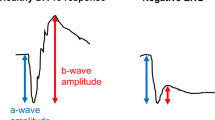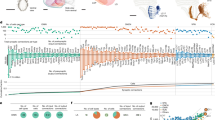Abstract
THE use of behavioural mutants of Drosophila to elucidate functions of the nervous system has produced several nonphototactic mutants snowing abnormality in the recorded waveform of the electroretinogram (ERG)1,2. We are working with a mutant strain of D. melanogaster which, though behaving phototactically positive in a T-maze under low ambient light, is visually impaired and behaves as though blind in a simple optomotor apparatus where normal, wild-type flies will orientate to visual cues3,4. The mutant appeared in a highly inbred line and is indistinguishable from the wild-type in external appearance. Detailed mapping is in progress but, at this stage, we know that the single Mendelian factor responsible is fully recessive and located on the third chromosome. The mutant eye has functional abnormality at the retinal level—yet, as in the nonphototactic mutants, histological sections of retinal structure of the mutant eye are indistinguishable from sections of wild-type eye under the light microscope.
Similar content being viewed by others
Article PDF
References
Pak, W. L., Grossfield, J., and White, N. V., Nature, 222, 351 (1969).
Hotta, Y., and Benzer, S., Nature, 222, 354 (1969).
Hecht, S., and Wald, G., J. Gen. Physiol., 17, 517 (1934).
Siegel, I. M., Anim. Behav., 15, 299 (1967).
Hengstenberg, R., and Gotz, K. G., Kybernetik, 3, 276 (1967).
Bernhard, C. G., J. Neurophysiol., 5, 32 (1942).
Ruck, P., in The Functional Organization of the Compound Eye (edit. by Bernhard, C. G.), 7, 195 (Pergamon Press, 1965).
Author information
Authors and Affiliations
Rights and permissions
About this article
Cite this article
COSENS, D., MANNING, A. Abnormal Electroretinogram from a Drosophila Mutant. Nature 224, 285–287 (1969). https://doi.org/10.1038/224285a0
Received:
Revised:
Issue date:
DOI: https://doi.org/10.1038/224285a0
This article is cited by
-
TRP channels associated with macrophages as targets for the treatment of obese asthma
Lipids in Health and Disease (2024)
-
Thermal gradient ring for analysis of temperature-dependent behaviors involving TRP channels in mice
The Journal of Physiological Sciences (2024)
-
TRPM channels in health and disease
Nature Reviews Nephrology (2024)
-
ROS-Activated TRPM2 Channel: Calcium Homeostasis in Cardiovascular/renal System and Speculation in Cardiorenal Syndrome
Cardiovascular Drugs and Therapy (2023)
-
TRP Channels in Stroke
Neuroscience Bulletin (2023)



